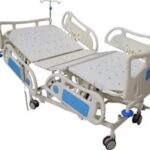In critical care settings, the smallest choices often make the most significant difference. One of those is the ICU bed—an essential part of patient care that’s often overlooked. Today’s ICU beds are no longer just basic frames; they’re built to respond to intense, fast-changing medical needs around the clock.
A well-designed bed isn’t just about function—it becomes part of the healing process. It supports movement, monitoring, and even emergency intervention. That’s why selecting the right one is a decision that deserves careful thought.
Why ICU Bed Design Matters More Than Ever
When patients are in intensive care, beds do much more than hold weight. They support treatment, help nurses respond faster, and reduce the physical stress on caregivers. Modern ICU beds come with must-have features like backrest elevation, height control, and side rails that fold away quickly when needed.
Hospitals across India are beginning to realise the actual value of these upgrades. In the past few years, reports show a sharp rise—nearly 40%—in demand for advanced ICU beds, especially in high-dependency units and speciality wards. The reason is simple: better beds lead to smoother workflows and safer care.
Features That Matter to Hospitals
Before choosing, it’s worth considering what your team needs most. If you’re looking at long-term use, steel frames with rust-resistant coatings are a safe bet. For ICUs with high patient turnover, ease of cleaning and infection control are equally important.
Top ICU bed suppliers offer designs that come with add-ons like oxygen tank holders, IV poles, and CPR boards. These aren’t extras—they’re practical tools that make a difference in urgent situations. Some even offer motorised control systems, allowing staff to reposition patients with minimal effort.
And don’t forget movement. A bed that glides smoothly and locks firmly can save seconds when every second counts.
Understanding the Market Shift
India’s healthcare infrastructure is expanding at pace. By 2030, experts predict the need for over half a million ICU beds nationwide. With that kind of growth, hospitals aren’t just buying—they’re investing.
As a result, procurement teams are leaning towards certified ICU bed suppliers who back up their products with warranties, service support, and compliance with standards like CE or BIS. That peace of mind is now part of what defines value.
Matching Your ICU Beds to Real-World Demands
The best bed isn’t just the most advanced or expensive. It’s the one that fits your workflow, suits your patient load, and is built to last. If you’re planning upgrades or starting fresh, keep one eye on adaptability. What works now should also work five years from now.
Beds should also be easy to integrate with accessories and hospital room layouts. Consider things like compatibility with nurse call systems, medical gas pipelines, and digital monitoring setups. A thoughtfully chosen bed reduces strain on staff and contributes to a more efficient care environment.
Conclusion
Well-built ICU beds do more than serve patients—it strengthens the entire care system. Hospitals are constantly upgrading their equipment to match rising expectations in clinical care.
For hospitals looking for reliable options that meet modern needs, Ankitech offers solutions worth exploring. Visit their website to view the latest models.

